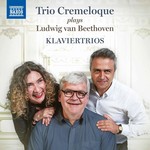
Beethoven: Piano Trios Nos. 3 & 4 / Allegretto in B-Flat Major (arr. for oboe, bassoon and piano)
 $25.00
Out of Stock
$25.00
Out of Stock6+ weeks add to cart
BEETHOVEN
Beethoven: Piano Trios Nos. 3 & 4 / Allegretto in B-Flat Major (arr. for oboe, bassoon and piano)
Trio Cremeloque
[ Naxos / CD ]
Release Date: Friday 18 October 2019
This item is currently out of stock. It may take 6 or more weeks to obtain from when you place your order as this is a specialist product.
The year is 1791. Wolfgang Amadeus Mozart dies. Late in the following year Ludwig van Beethoven departs from Bonn to Vienna. Upon his arrival the news comes that his father is no longer among the living. For a 22-year-old man, those two deaths must have been a strong blow, despite the fact that his relationship with his father had been far from ideal. Mozart was a significant role model for Beethoven, and even if music history cannot confirm that the two composers actually met, it is known that Beethoven spent a lot of time studying Mozart's oeuvre. Losing both his biological father and one of his musical fathers must have made Beethoven mature more quickly. The start of his professional career followed shortly after. In 1795 his earliest composition with opus number was published in Vienna, the Piano Trio Op.1 No.3 in C minor. This piece is to be heard on the present album in a different instrumentation from the one Beethoven originally imagined: oboe and bassoon take the parts of violin and violoncello respectively.
The most intriguing aspect of Op.1 No.3 is that it already announces the "real" mature and dramatic Beethoven, and as we know today, this early work of the young piano virtuoso, who regularly played at the salons of the aristocracy, will later become one of his most famous. In all four movements of this Trio we are aware of many Beethoven fingerprints: the way the musical sentence is constructed, the sequencing and phrasing of the material, the melody that springs from an idiom rather instrumental than vocal, as well as the long-range architectural use of tonality. The opening of the last movement (Prestissimo) already signals the passionate master of orchestral sound, some of whose symphonies (and above all Nos.5 and 9) are an indelible part of the world's heritage of classical music in general. A pre-echo of that well-known symphonic idiom is already present in this early Trio. Dramatic effects and composition techniques used in the Fifth Symphony already germinate in the Trio's finale. And somewhat unexpectedly, Beethoven the symphonic master is more evident in the Cremloque's instrumentation than in the originally imagined trio with strings. Through their virtuosic, intelligent and witty interpretation and their profound understanding of Beethoven's musical world, the Cremeloque Trio becomes a kind of audio "magnifying glass" that reveals Beethoven's score in its symphonic dimension.
Trio Cremeloque undertake a different challenge in their performance of Beethoven's Trio Op.11 in B major, composed two years after Op.1. That work became known as the "Gassenhauer (street song) Trio" on account of its final movement, a set of variations on the melody "Pria ch'io l'impegno" from Joseph Weigl's opera "L'amor marinaro ossia Il corsaro" (1597). The composer and conductor Joseph Weigl was particularly known for his Singspielen and operas written in the Italian style. Trio Cremeloque perform the Trio Op.11 with virtuosic flair, humor and a sense of drama, playfully exhibiting a kaleidoscope of different musical moods. The enjoyment and mutual understanding with which they make music together is vital and captivating. Their musical dialogue is sincere, intimate, playful and rewarding. The last movement of the Trio Op.11 profoundly illuminates the complexities of their rich musical friendship, reinventing Beethoven's music for string trio by reading it through different (symphonic, operatic) protocols and contexts.
With the Allegretto for Piano Trio in B-flat major, WoO 39 Beethoven's music emanates a more lyrical, Mozart-like glow. The piece was composed in 1812 for Maximiliane Brentano, the then ten-year-old daughter of Beethoven's friend Antonie Brentano, to encourage her to play the piano. Besides its instructional character, this piece's sfumato lyricism positions it high on the map of requisite skills and performing sensibilities for musicians. Since they are no less in command of Beethoven's slow movements as of his finales, Cremeloque once more demonstrate a rich palette of interpretative skills, such that the act of listening becomes a meditative experience. For example Trio Cremeloque opts for a slower tempo for the Allegretto than is usually the case and the lyric dimension of the score is foregrounded by this decision.
Tracks:
Allegretto in B-Flat Major, WoO 39 (arr. for oboe, bassoon and piano)
Piano Trio No. 3 in C Minor, Op. 1, No. 3 (arr. for oboe, bassoon and piano)
Piano Trio No. 4 in B-Flat Major, Op. 11, "Gassenhauer" (arr. for oboe, bassoon and piano)